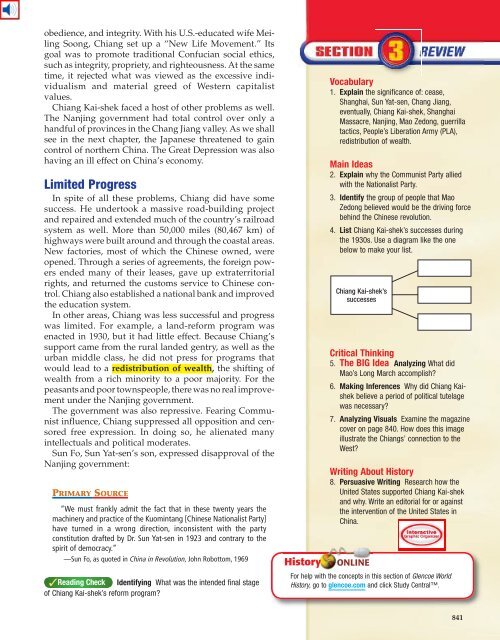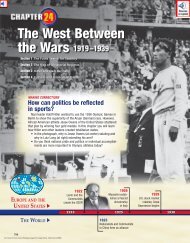Chapter 25 Text - APAblog.org
Chapter 25 Text - APAblog.org
Chapter 25 Text - APAblog.org
Create successful ePaper yourself
Turn your PDF publications into a flip-book with our unique Google optimized e-Paper software.
obedience, and integrity. With his U.S.-educated wife MeilingSoong, Chiang set up a “New Life Movement.” Itsgoal was to promote traditional Confucian social ethics,such as integrity, propriety, and righteousness. At the sametime, it rejected what was viewed as the excessive individualismand material greed of Western capitalistvalues.Chiang Kai-shek faced a host of other problems as well.The Nanjing government had total control over only ahandful of provinces in the Chang Jiang valley. As we shallsee in the next chapter, the Japanese threatened to gaincontrol of northern China. The Great Depression was alsohaving an ill effect on China’s economy.Limited ProgressIn spite of all these problems, Chiang did have somesuccess. He undertook a massive road-building projectand repaired and extended much of the country’s railroadsystem as well. More than 50,000 miles (80,467 km) ofhighways were built around and through the coastal areas.New factories, most of which the Chinese owned, wereopened. Through a series of agreements, the foreign powersended many of their leases, gave up extraterritorialrights, and returned the customs service to Chinese control.Chiang also established a national bank and improvedthe education system.In other areas, Chiang was less successful and progresswas limited. For example, a land-reform program wasenacted in 1930, but it had little effect. Because Chiang’ssupport came from the rural landed gentry, as well as theurban middle class, he did not press for programs thatwould lead to a redistribution of wealth, the shifting ofwealth from a rich minority to a poor majority. For thepeasants and poor townspeople, there was no real improvementunder the Nanjing government.The government was also repressive. Fearing Communistinfluence, Chiang suppressed all opposition and censoredfree expression. In doing so, he alienated manyintellectuals and political moderates.Sun Fo, Sun Yat-sen’s son, expressed disapproval of theNanjing government:PRIMARY SOURCE“We must frankly admit the fact that in these twenty years themachinery and practice of the Kuomintang [Chinese Nationalist Party]have turned in a wrong direction, inconsistent with the partyconstitution drafted by Dr. Sun Yat-sen in 1923 and contrary to thespirit of democracy.”—Sun Fo, as quoted in China in Revolution, John Robottom, 1969✓Reading Check Identifying What was the intended final stageof Chiang Kai-shek’s reform program?Vocabulary1. Explain the significance of: cease,Shanghai, Sun Yat-sen, Chang Jiang,eventually, Chiang Kai-shek, ShanghaiMassacre, Nanjing, Mao Zedong, guerrillatactics, People’s Liberation Army (PLA),redistribution of wealth.Main Ideas2. Explain why the Communist Party alliedwith the Nationalist Party.3. Identify the group of people that MaoZedong believed would be the driving forcebehind the Chinese revolution.4. List Chiang Kai-shek’s successes duringthe 1930s. Use a diagram like the onebelow to make your list.Chiang Kai-shek’ssuccessesCritical Thinking5. The BIG Idea Analyzing What didMao’s Long March accomplish?6. Making Inferences Why did Chiang Kaishekbelieve a period of political tutelagewas necessary?7. Analyzing Visuals Examine the magazinecover on page 840. How does this imageillustrate the Chiangs’ connection to theWest?Writing About History8. Persuasive Writing Research how theUnited States supported Chiang Kai-shekand why. Write an editorial for or againstthe intervention of the United States inChina. For help with the concepts in this section of Glencoe WorldHistory, go to glencoe.com and click Study Central.841



